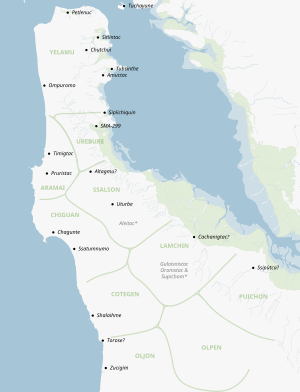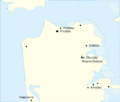Ramaytush facts for kids
The Ramaytush people are a group of Ohlone people from Northern California. The name Ramaytush was first used for them in the 1970s. Today, the Ohlone people living on the San Francisco Peninsula proudly use this name for themselves. For hundreds of years, the ancestors of the Ramaytush Ohlone lived on the peninsula. This area includes modern San Francisco and San Mateo County, California.
Before a very difficult time for California's native people, the Ohlone groups were not united as one big political group. In the early 1900s, experts started calling the Ramaytush Ohlone "San Francisco Costanoans." This was because they spoke a shared language or dialect. Other Ohlone groups, like the Tamien people and Awaswas, were called "Santa Clara Costanoans" and "Santa Cruz Costanoans."
The Ramaytush homeland is mostly surrounded by the ocean. The only land connection is to the southeast, where the Santa Clara Valley and Santa Cruz Mountains are. This area was home to the Tamien people and Awaswas Ohlone. To the east, across San Francisco Bay, is Alameda County, California. This is where the Chochenyo Ohlone lived. North of the Golden Gate was a Coast Miwok village. The northernmost Ramaytush group, the Yelamu tribe in San Francisco, had strong ties with the Huchiun Chochenyos from Oakland. People from these two tribes often married each other when the Spanish arrived.
European diseases greatly harmed all Indigenous peoples of California who came to Mission San Francisco de Asís after it was built in 1776. The Ohlone people were forced to use Spanish, which led to the loss of their own language. The Spanish gathered many Ohlone people at Mission Dolores. They took them to the north bay to build Mission San Rafael Arcángel. This mission was then used as a hospital for sick native people. Some people thought the west bay people were gone by 1915. However, four family lines are known to have survived this difficult period. The Muwekma Ohlone Tribe and other Ohlone groups are strong supporters for Native American rights on the San Francisco Peninsula today.
Contents
What Does "Ramaytush" Mean?
The word "Ramaytush" (Rammay-tuš) means "people from the west." It comes from the Chochenyo language. The Chochenyo Ohlone people from the East Bay used this word to describe their neighbors to the west. In 1976, a researcher named Richard L. Levy started using the term "Ramaytush" to describe the language group on the peninsula.
Ramaytush Groups and Villages
The Ramaytush people lived in many independent local groups or tribes. Here are some of their villages:
Yelamu Group Villages
The Yelamu group was likely a multi-village tribe. Their villages were located within what is now the City and County of San Francisco:
- Chutchui (also called Suchui) – This village was on Mission Creek, near Mission San Francisco de Asís. The mission gave it the Christian name Nuestra Senora de la Asumpcion. The burial ground for Chutchui was where the Marshall school is today (15th Street & Capp Street).
- Sitlintac (also called Sitinac) – This village was close to Chutchui.
- Amuctac and Tubsinte – These were in Visitacion Valley, San Francisco.
- Amutaja – This village was next to Canada de la Visitacion.
- Petlenuc – This village was near the Presidio of San Francisco.
- Mitline – This village was near Lake Merced.
- Opurome – This village was on the beach side of Lake Merced.
Villages South of San Francisco (Bay Side)
These villages were located along San Francisco Bay, south of the city:
- Siplichiquin – On San Bruno Mountain in South San Francisco, California.
- An unnamed village (CA-SMA-299) – On present-day El Camino Real in South San Francisco, California.
- Urebure – Near San Bruno Creek and San Bruno Mountain.
- Altamu – In San Mateo.
- Chagunte – In San Bruno.
- Chioischin – In San Bruno.
- Malsaitac – Near San Mateo.
- Shalson (also spelled Ssalson) – Along San Mateo Creek and in the San Andreas Valley (modern San Mateo, California). Their villages included:
- Aleitac – Along San Mateo Creek in San Andreas Valley.
- Altahmo (also spelled Altagmu) – Along San Mateo Creek, in San Mateo or San Andreas Valley.
- Tunmuda – Near San Mateo Creek.
- Uturbe – Along San Mateo Creek, likely in San Mateo.
- Lamchin – Lived along Pulgas Creek in modern San Carlos, California. Other nearby villages were:
- Chachanegtac – The main village along Pulgas Creek.
- Ussete – Near Pulgas Creek.
- Gulcismijtac (also spelled Guloisnistac) – North of Pulgas Creek.
- Oromstac – Near Pulgas Creek.
- Supichum (also spelled Ssupichom) – In San Mateo.
- Puichon – In the lower San Francisquito Creek area (modern Palo Alto, California and Mountain View, California).
Villages South of San Francisco (Pacific Coast)
These villages were located along the Pacific Coast, south of San Francisco:
- Aramai – In coastal valleys just south of San Francisco. Its villages were:
- Timigtac – On Calera Creek in modern Pacifica.
- Pruristac – On San Pedro Creek in modern Pacifica.
- Chiguan – Its villages were:
- Ssatumnumo – At Princeton Point.
- Chagunte – Near Half Moon Bay.
- Cotegen – At Tunitas Creek and nearby areas south of Half Moon Bay.
- Oljon – In the lower San Gregorio and Pescadero creeks, north of Point Ano Nuevo.
Other Villages (Rancherias)
The Spanish missionaries also recorded other villages, called Rancherias, but their exact locations are not known:
- Aluenchi
- Amictu
- Atarpe
- Chimus
- Chirau
- Chocoayco
- Chupanes
- Chynan Jumiamuc
- Conap
- Cosapa
- Geluasibe
- Liuanegtur
- Macsinum
- Olestura
- Ousint
- Payesone
- Pusuay
- Septuca
- Subchiam
- Toquisara
- Tuzsint
- Uturpe
Important Ramaytush Ohlone People
Here are some notable Ramaytush Ohlone individuals mentioned in historical records:
- Chamis (1777) – From the village Chutchui. He was the first native person to be baptized at Mission San Francisco on June 24, 1777, at age 20. He was given the Christian name Francisco Moraga. He was also the first to be married at the mission on April 27, 1778, to Catarina de Bononia. Between 1777 and 1850, 7,280 Ohlone people were baptized at Mission Dolores.
- Pilmo (1777) – From Playa de la Dolores. He was the second person baptized on June 24, 1777, and named Jose Antonio.
- Taulvo (1777) – Also from Playa de la Dolores. He was the third person baptized on June 24, 1777, and named Juan Bernardino.
- Xigmacse (1777) – A Yelamu chief when Mission San Francisco was founded.
- Charquín (1779) – Given the baptismal name Francisco. He was a leader of a group who ran away from the mission in 1789. He was sent to San Diego and died there in 1798.
- Mossués (1783) – The leader of the village Pruristac. He was baptized in 1783.
- Valeriano and Jorge (1797) – They were elected Alcalde (a type of mayor) of Mission San Francisco de Assis. California's first governor, Felipe de Neve, ordered missions to elect local Alcaldes around 1779.
- Acursio and Fermin (1797) – They were elected regidores (council members) at Mission San Francisco de Assis.
- Biridianna (1798) – She was the last living Chutchui villager who remembered the founding of Mission Dolores.
- Hilarion and George (1807) – These two Ohlone men from the village Pruristac served as alcaldes (mayors) of Mission San Francisco in 1807.
- Pomponio (18??-1823) – From Half Moon Bay, California. He led raids against Mission Dolores, taking animals. He was caught, escaped, caught again, and then killed.
- Monica (18??) – He worked as a boatman for William Richardson. Monica shared stories about a time before the opening now known as the Golden Gate.
- José Antonio (1842) – Age 16, one of the last twelve known Ohlone people living in San Francisco. All Ohlone people at the Mission were given a Catholic saint's name upon baptism. They were not given last names in the census.
- Alejo (1842) – Age 35, one of the last twelve known Ohlone people living in San Francisco.
- Pablo (1842) – Age 18, one of the last twelve known Ohlone people living in San Francisco.
- Junipero (1842) – Age 43, one of the last twelve known Ohlone people living in San Francisco.
- José Ramon (1842) – Age 16, one of the last twelve known Ohlone people living in San Francisco.
- Josefa (1842) – Age 14, one of the last twelve known Ohlone people living in San Francisco.
- Consolacion (1842) – Age 12, one of the last twelve known Ohlone people living in San Francisco.
- Ygnacio (1842) – Age 53, one of the last twelve known Ohlone people living in San Francisco.
- Dunas (1842) – Age 49, one of the last twelve known Ohlone people living in San Francisco.
- Forcuata (1842) – Age 40, one of the last twelve known Ohlone people living in San Francisco.
- José (1842) – Age 16, one of the last twelve known Ohlone people living in San Francisco.
- José D. (1842) – Age 3, one of the last twelve known Ohlone people living in San Francisco.
- Pedro Evencio (1893) – He has been called the last Ramaytush Native American of San Mateo. His son, José Evencio, lived at Coyote Point until World War II. His final location is unknown.
- Andrés Osorio (1950s) – From Half Moon Bay, California. He was said to be the last "Indian" in the area.
Images for kids




